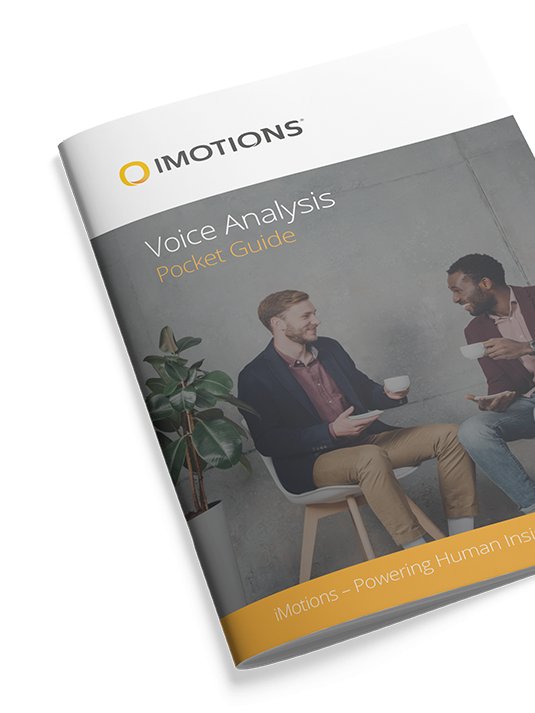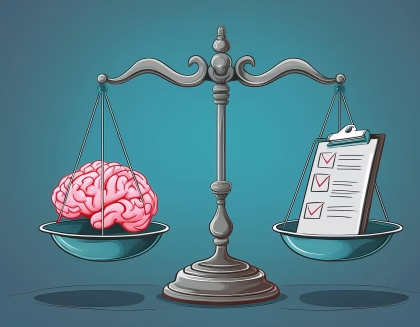Explore the world of emotional prosody with iMotions’ latest update. Uncover how speech unveils human emotions beyond words, through pitch, rhythm, and intonation. Dive into this comprehensive guide to understanding and leveraging emotional prosody in behavioral research.
Table of Contents
- Unlocking New Dimensions in Emotion Analysis with Voice Technology
- What Is Emotional Prosody?
- Why Is Emotional Prosody Important?
- Defining Emotional Prosody
- The Role of Pitch in Emotional Prosody
- Understanding the Role of Rhythm and Timing in Speech
- How Tempo Shapes Emotional Expression
- The Role of Pauses in Emotional Impactful Speech
- Pauses and Their Connection to Truthfulness
- The Role of Loudness in Speech Veracity
- Integrating Prosodic Features for Deeper Insights
- How Intensity and Duration Shape Emotional Expression in Speech
- Cross-Cultural Differences and Individual Traits in Emotional Prosody
- Practical Applications and Real-World Implications of Emotional Prosody
- Conclusion
- Free 22-page Voice Analysis Guide
- References:
Unlocking New Dimensions in Emotion Analysis with Voice Technology
The integration of voice analysis into the iMotions Software suite has opened exciting opportunities for emotion research. By analyzing the emotional dimensions of speech, researchers can uncover hidden layers of communication in respondent testimonies, adding depth and nuance to their studies. This capability centers around a fascinating aspect of speech known as emotional prosody (or affective prosody).
In this article, we’ll explore what emotional prosody is and how it can enhance behavioral research.
What Is Emotional Prosody?
Emotional prosody is the study of how emotions are conveyed and perceived through the acoustic qualities of speech. These qualities include variations in pitch, rhythm, and intonation that express sentiments beyond the literal meaning of words.
Why Is Emotional Prosody Important?
This subtle yet powerful aspect of communication provides deeper insights into human expression. By understanding the mechanics of emotional prosody, researchers can better grasp its role in everyday interactions and its significance in revealing the true emotional intent behind spoken language.
With this knowledge, behavioral researchers can elevate their studies, unlocking richer insights into the emotional layers of human speech.
Defining Emotional Prosody
In linguistics and the study of human behavior, emotional prosody refers to the modulation of acoustic elements in speech-such as pitch, rhythm, intensity, and duration-to express emotions. Unlike the literal meaning of words, emotional prosody is a non-verbal aspect of language that enables the expression and recognition of feelings in spoken communication.

This subtle yet powerful phenomenon works alongside the semantic content of speech, adding an emotionally rich layer to verbal expression. By studying both the production (how emotions are conveyed) and perception (how emotions are understood) of these acoustic modulations, researchers can gain deeper insights into the complex relationship between language and emotion.
The Role of Pitch in Emotional Prosody
Pitch is arguably the most prominent feature of emotional prosody and plays a key role in conveying emotional states. Research consistently shows a strong connection between pitch variations and specific emotions.
For example, a wider pitch range and higher average pitch are often associated with positive emotions like joy or excitement. In contrast, a flatter pitch contour is commonly linked to negative emotions such as sadness or anger (Juslin & Laukka, 2003; Scherer, 1986).
This dynamic use of pitch provides valuable insights into how emotions are expressed and perceived in spoken communication, making it a critical focus in the study of emotional prosody.while a flatter pitch contour may indicate negative emotions like sadness or anger (Juslin & Laukka, 2003; Scherer, 1986).
Understanding the Role of Rhythm and Timing in Speech
The rhythmic aspects of speech, including tempo and timing, are key components of emotional prosody, the vocal patterns that convey emotions and intent. By altering speech speed or inserting pauses, speakers can create profound emotional effects that shape how their message is received.
How Tempo Shapes Emotional Expression
The tempo of speech significantly affects how emotions are communicated. Speaking at an accelerated tempo often conveys excitement, urgency, or enthusiasm. For example, a salesperson might speak quickly to create a sense of urgency in a pitch. Conversely, a slower tempo can evoke contemplation, sadness, or calmness, such as during a heartfelt eulogy.
Examples of Tempo in Emotional Communication
- Fast Tempo: Signals enthusiasm or urgency, e.g., a coach motivating a team before a game.
- Slow Tempo: Reflects thoughtfulness or sadness, e.g., a speaker addressing a serious topic.
By intentionally modulating tempo, speakers can amplify their emotional impact and connect with their audience more effectively.
The Role of Pauses in Emotional Impactful Speech
Pauses, both silent and vocalized, are powerful tools for emotional expression. Strategic pauses can:
- Emphasize Key Points: A pause before a significant phrase creates anticipation.
- Enhance Tension: Silence after an emotional statement allows the audience to absorb its weight.
- Improve Clarity: Breaks help listeners process complex ideas.
For instance, an orator might pause before delivering a climactic line in a speech to heighten its impact. Research by Livingstone & Thomson (2009) underscores the importance of pauses in emotional prosody, demonstrating their role in shaping emotional resonance.
Pauses and Their Connection to Truthfulness
Pauses are not just about emotion; they also reveal cognitive processes, especially during deceptive communication. Studies suggest a correlation between the frequency of pauses-silent and vocalized-and truthfulness.
Key Findings
- Vocalized Pauses: Deceptive speech tends to include more vocalized pauses like “um” compared to “uh.”
- Prolonged Duration: Pauses in deceptive speech often last longer, reflecting the speaker’s increased mental effort.
- Placement of Pauses: Deceptive pauses frequently occur within extended silent intervals, as speakers formulate their responses.
These findings indicate that pauses can act as markers of cognitive monitoring, providing valuable insights into the speaker’s honesty.
The Role of Loudness in Speech Veracity
In emotional communication, loudness plays a more prominent role than pitch in influencing perceptions of truthfulness. For example:
- Consistent Loudness: Suggests confidence and sincerity.
- Fluctuating Loudness: May indicate hesitation, uncertainty, or deception.
While pitch contributes to emotional tone, loudness offers clearer cues for identifying speech veracity.
Integrating Prosodic Features for Deeper Insights
Research, such as that by Benus et al. (2006), advocates for analyzing speech holistically by combining prosodic elements like pauses and loudness with additional lexical and speaker-specific features. Machine-learning models have shown promise in this area, improving accuracy in identifying emotional states and detecting deception.
How Intensity and Duration Shape Emotional Expression in Speech
Intensity and duration play key roles in shaping emotions in speech. Intensity, which relates to how loud or soft speech is, helps express emotions. Louder speech can show excitement or anger, while softer speech might suggest sadness or calmness.
Duration refers to how long sounds, pauses, and speech patterns last. Long vowels, extended pauses, or fast speech all add meaning to emotions. These factors together shape how emotions are shared through speech, helping us understand feelings in communication.

Cross-Cultural Differences and Individual Traits in Emotional Prosody
Culture and personal traits both shape how emotions are expressed through speech. Different cultures have unique ways of using tone and rhythm to show feelings. Cultural rules, language, and history all affect how people use and understand emotional speech.
At the same time, personal traits add another layer of variety. Personality, thinking styles, and life experiences can change how someone expresses or understands emotions. For example, an outgoing person might use more dramatic tones, while a quieter person might express emotions gently. These differences show how both culture and individuality influence emotional communication. To fully understand emotional speech, it’s important to consider both these aspects.
Practical Applications and Real-World Implications of Emotional Prosody
Understanding emotional prosody goes far beyond theoretical interest, playing a significant role in numerous practical fields such as human-computer interaction, artificial intelligence, and clinical psychology.
For instance, the ability to recognize and replicate emotional prosody in speech synthesis systems has been instrumental in creating virtual assistants that feel more natural and emotionally engaging. By improving their ability to convey empathy and respond appropriately to users’ emotional states, these systems foster better communication and user satisfaction.
In clinical settings, the analysis of emotional prosody offers valuable insights into psychological health. It has proven useful in diagnosing and treating a range of psychological disorders, such as autism spectrum disorders, mood disorders, and even depression.
For individuals with autism, prosody analysis can highlight challenges in emotional expression, providing therapists with actionable data to guide interventions. Similarly, mood disorder patients may exhibit distinct prosodic patterns, which can be monitored to assess treatment progress or detect relapses (Paulmann & Uskul, 2014).
Additionally, emotional prosody research has implications for education and social training. Programs designed to enhance emotional literacy and communication skills can use prosody insights to teach individuals how to better express and interpret emotions through speech. These applications underscore the importance of emotional prosody as a bridge between scientific understanding and real-world problem-solving, emphasizing its role in advancing technology, healthcare, and interpersonal communication.
Conclusion
Emotional prosody serves as a crucial link between people as well as a captivating bridge between linguistics and psychology, unraveling the intricate ways our voices encode and decode emotions. As researchers continue to probe the depths of this fascinating domain, the implications for improving our understanding of human communication and enhancing technological applications are boundless.
Free 22-page Voice Analysis Guide
For Beginners and Intermediates
- Get a thorough understanding of the essentials
- Valuable Voice Analysis research insight
- Learn how to take your research to the next level

References:
- Juslin, P. N., & Laukka, P. (2003). Communication of emotions in vocal expression and music performance: Different channels, same code? Psychological bulletin, 129(5), 770. https://psycnet.apa.org/record/2003-99991-007
- Livingstone, S. R., & Thompson, W. F. (2009). The emergence of music from the Theory of Mind. Musicae Scientiae, 13(2_suppl), 83-115. https://journals.sagepub.com/doi/10.1177/1029864909013002061
- Benus, S., Enos, F., Hirschberg, J., & Shriberg, E. (2006). Pauses in Deceptive Speech. https://doi.org/10.7916/D8SQ97TG
- Paulmann, S., & Uskul, A. K. (2014). Cross-cultural emotional prosody recognition: Evidence from Chinese and British listeners. Cognition and Emotion, 28(2), 230-244.https://pubmed.ncbi.nlm.nih.gov/23862740/











